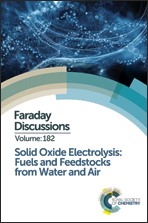Degradation of (La0.8Sr0.2)0.98MnO3−δ–Zr0.84Y0.16O2−γ composite electrodes during reversing current operation
Abstract
Reversing-current operation of solid oxide cell (La0.8Sr0.2)0.98MnO3−δ–Zr0.84Y0.16O2−γ (LSM–YSZ) oxygen electrodes is described. Degradation was characterized by impedance spectroscopy in symmetric cells tested at 800 °C in air with a symmetric current cycle with a period of 12 hours. No change in cell resistance could be detected, in 1000 h tests with a sensitivity of ∼1% per kh, at a current density of 0.5 A cm−2 corresponding to an overpotential of 0.18 V. At a current density to 0.6 A cm−2 (0.33 V overpotential) measurable resistance degradation at a rate of 3% per kh was observed, while higher current/overpotential values led to faster degradation. Degradation was observed mainly in the ohmic resistance for current densities of 0.6, 0.8 and 0.9 A cm−2, with little change in the polarization resistance. Polarization degradation, mainly observed at higher current density, was present as an increase in an impedance response at ∼30 kHz, apparently associated with the resistance of YSZ grain boundaries within the electrode. Microstructural and chemical analysis showed significant changes in electrode structure after the current cycling, including an increase in LSM particle size and a reduction in the amount of YSZ and LSM at the electrode/electrolyte interface – the latter presumably a precursor to delamination.
- This article is part of the themed collection: Solid Oxide Electrolysis: Fuels and Feedstocks from Water and Air

 Please wait while we load your content...
Please wait while we load your content...